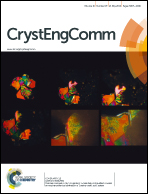Three-color polymorph-dependent luminescence: crystallographic analysis and theoretical study on excited-state intramolecular proton transfer (ESIPT) luminescence of cyano-substituted imidazo[1,2-a]pyridine†
Abstract
Three solid-state luminescence colors, yellow, orange, and red, can be achieved by controlling the crystalline polymorphs of 6-cyano-2-(2′-hydroxyphenyl)imidazo[1,2-a]pyridine (2). This study investigates the relationship between the emission properties and the crystal structure of 2. All luminescence is assigned as a singlet excited-state intramolecular proton transfer (ESIPT) emission. X-ray crystallographic analyses of the three crystals show that there are remarkable differences in the molecular packing: herringbone-like, antiparallel dimer stacking and two slip-stacked, parallel stacking modes, with similar coplanar molecular conformation. Density functional theory (DFT) calculations show that the dipole moment of the ground state enol form is much smaller (1.66 D) than that of the parent compound 1 (5.40 D), which may be the reason why parallel stacking is energetically allowed. The luminescence colors are well reproduced from quantum chemical calculations of the intramolecular proton transfer (IPT) species, which are optimized by the two-layer ONIOM cluster models extracted from the corresponding crystal structure. The results indicate that the intermolecular interactions of the π-stacked IPT and enol molecules are a decisive factor in the emission energy of the crystalline polymorphs. Furthermore, the dipole moments of the excited (4.99 D) and ground states (3.70 D) of the IPT species are found to orient in a high-angled manner (ca. 150°). Therefore, the energy levels of the two states shift differently upon environmental variation, resulting in a change in the luminescence energy. Thus, the three-color, polymorph-dependent luminescence of 2 is rationally explained with crystallographic analyses and quantum chemical simulations. The results presented here will contribute to understanding the structure–property relationships of solid-state luminescence at the molecular level and further design of new polymorph-dependent luminescent materials.
![Graphical abstract: Three-color polymorph-dependent luminescence: crystallographic analysis and theoretical study on excited-state intramolecular proton transfer (ESIPT) luminescence of cyano-substituted imidazo[1,2-a]pyridine](/en/Image/Get?imageInfo.ImageType=GA&imageInfo.ImageIdentifier.ManuscriptID=C3CE42627K&imageInfo.ImageIdentifier.Year=2014)

 Please wait while we load your content...
Please wait while we load your content...